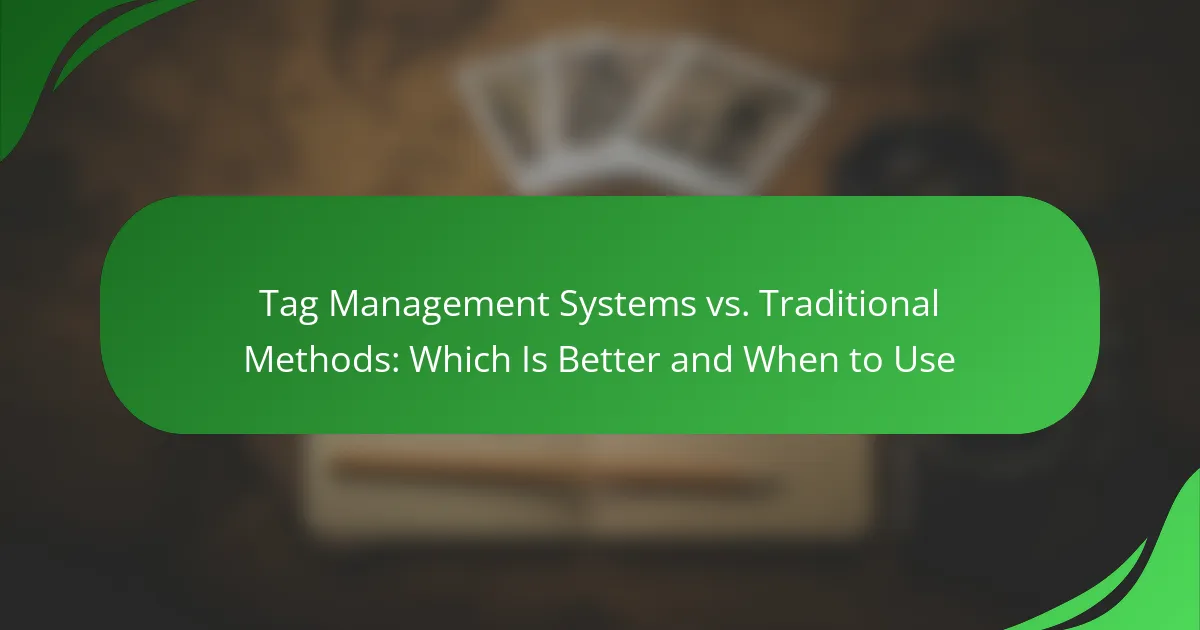Tag management systems (TMS) are essential tools for businesses looking to optimize their marketing and analytics efforts. By providing flexibility and ease of integration, these systems allow companies to manage and deploy tags efficiently, enhancing data accuracy and performance. Popular options like Google Tag Manager and Adobe Experience Platform Launch cater to diverse needs, making it easier for organizations to streamline their digital strategies.

What are the best tag management systems for Canadian businesses?
The best tag management systems for Canadian businesses include tools that offer flexibility, ease of integration, and robust features tailored to local needs. Key options such as Google Tag Manager, Adobe Experience Platform Launch, Tealium iQ Tag Management, Ensighten, and Segment provide various functionalities to help streamline marketing efforts and improve data management.
Google Tag Manager
Google Tag Manager (GTM) is a widely used tag management system that allows businesses to manage and deploy marketing tags without extensive coding knowledge. It integrates seamlessly with Google Analytics and other Google services, making it a popular choice for Canadian businesses looking to enhance their online tracking capabilities.
GTM offers features like version control, user permissions, and a built-in debugging tool, which can significantly reduce the time spent on tag implementation. Businesses should ensure they regularly review their tags to maintain optimal performance and compliance with local regulations.
Adobe Experience Platform Launch
Adobe Experience Platform Launch is a powerful tag management solution designed for enterprises that require advanced data management capabilities. It allows for easy integration with Adobe’s suite of marketing tools, enabling businesses to create personalized experiences based on user data.
When using Adobe Launch, Canadian businesses should consider its flexibility in managing third-party tags and the ability to create rules for tag firing. However, it may require a steeper learning curve compared to simpler tools, so training and support may be necessary for effective implementation.
Tealium iQ Tag Management
Tealium iQ Tag Management is known for its robust data layer capabilities and extensive integration options. It enables businesses to manage tags across multiple platforms while ensuring data consistency and compliance with privacy regulations, which is crucial for Canadian companies.
Tealium’s user-friendly interface allows for quick tag deployment and management. Businesses should leverage its features like audience segmentation and real-time data collection to enhance their marketing strategies and improve customer engagement.
Ensighten
Ensighten is a tag management system that focuses on data privacy and security, making it suitable for businesses that handle sensitive information. It offers advanced features like real-time data governance and compliance management, which are essential for Canadian businesses adhering to privacy laws.
While Ensighten provides powerful tools for managing tags, it may come with higher costs compared to other options. Companies should evaluate their specific needs and budget to determine if the investment aligns with their marketing goals.
Segment
Segment is a customer data platform that also offers tag management capabilities, allowing businesses to collect, unify, and activate customer data across various channels. It is particularly beneficial for Canadian businesses looking to create a comprehensive view of their customers.
With Segment, companies can easily integrate with numerous marketing and analytics tools, streamlining data flow and improving decision-making. Businesses should focus on setting up clear data governance practices to maximize the benefits of using Segment for tag management.

How to integrate a tag management system?
Integrating a tag management system (TMS) involves connecting it to your website or application to streamline the management of marketing and analytics tags. This process enhances flexibility and control over tracking and data collection without extensive coding.
Step-by-step integration process
Begin by selecting a suitable tag management system that meets your business needs. Popular options include Google Tag Manager, Adobe Launch, and Tealium. Once chosen, create an account and set up a new container for your website.
Next, add the TMS code snippet to your website’s header, ensuring it loads on all pages. This code acts as a bridge between your site and the TMS, enabling it to manage tags effectively. After implementation, configure your tags within the TMS interface, specifying triggers and variables as needed.
Finally, test the integration using built-in debugging tools to verify that tags fire correctly and data is collected as intended. Regularly review and update your tags to adapt to changing marketing strategies or website updates.
Common integration challenges
One common challenge is ensuring that the TMS code is correctly placed within the website’s code. If the snippet is missing or incorrectly implemented, tags may not function as expected, leading to data loss or inaccurate tracking.
Another issue can arise from conflicts with existing scripts or tags. It’s crucial to audit current tags and scripts before integration to minimize compatibility problems. Additionally, team members may require training to effectively use the TMS, which can slow down initial implementation.
To mitigate these challenges, maintain clear documentation of your integration process and conduct thorough testing. Regularly communicate with your team about updates and changes to ensure everyone is aligned on tag management strategies.

What are the benefits of using a tag management system?
A tag management system (TMS) streamlines the process of managing and deploying marketing and analytics tags on a website. By centralizing tag management, businesses can improve performance, enhance data accuracy, and increase marketing agility.
Improved website performance
Using a tag management system can significantly enhance website performance by reducing page load times. A TMS allows for asynchronous loading of tags, meaning that tags do not block the rendering of the webpage, leading to a smoother user experience.
Additionally, a TMS can help minimize the number of tags fired on a page, which can further improve loading speeds. Regularly auditing and optimizing tags within the TMS can keep performance at its peak.
Enhanced data accuracy
Tag management systems improve data accuracy by ensuring that tags are implemented correctly and consistently across all pages. This reduces the risk of errors that can occur with manual tag insertion, which often leads to inaccurate data collection.
Moreover, a TMS enables version control and testing capabilities, allowing marketers to validate tags before they go live. This ensures that data collected is reliable and actionable, which is crucial for informed decision-making.
Increased marketing agility
A tag management system enhances marketing agility by allowing teams to quickly deploy and modify tags without needing extensive IT support. This flexibility means that marketers can respond rapidly to changing campaign needs or market conditions.
Furthermore, a TMS typically includes user-friendly interfaces that enable non-technical users to manage tags effectively. This democratization of tag management empowers marketing teams to take control of their data strategies, leading to faster execution of marketing initiatives.

What factors to consider when choosing a tag management system?
When selecting a tag management system (TMS), consider scalability, ease of use, integration capabilities, and support for various data types. These factors ensure that the TMS can grow with your business needs and be accessible to all team members, regardless of their technical expertise.
Scalability for future needs
Scalability is crucial when choosing a tag management system, as it determines how well the system can handle increased traffic and additional tags over time. Look for a TMS that can support a growing number of tags without compromising performance, ideally allowing for hundreds or thousands of tags as your business expands.
Consider systems that offer flexible pricing models based on usage, which can help manage costs as your needs evolve. A scalable TMS should also provide features like automated tag deployment and version control to streamline updates and adjustments.
Ease of use for non-technical users
Ease of use is essential for ensuring that non-technical users can effectively manage tags without requiring extensive training. A user-friendly interface with drag-and-drop functionality can significantly reduce the learning curve and allow marketing teams to implement changes quickly.
Look for a TMS that provides clear documentation, tutorials, and customer support to assist users. Additionally, features like templates for common tags and a visual representation of tag structures can enhance usability and empower teams to make data-driven decisions efficiently.

How does tag management impact data privacy in Canada?
Tag management systems (TMS) can significantly influence data privacy in Canada by streamlining how organizations collect and manage user data. Effective use of TMS can enhance compliance with privacy regulations, but it also requires careful consideration of data handling practices to protect user information.
Compliance with PIPEDA
Compliance with the Personal Information Protection and Electronic Documents Act (PIPEDA) is crucial for organizations operating in Canada. Tag management systems must be configured to ensure that any data collected through tags adheres to PIPEDA’s principles, including obtaining consent and providing transparency about data usage.
Organizations should regularly audit their tag implementations to verify that they are not inadvertently collecting personal information without consent. This includes ensuring that third-party tags are compliant and that data sharing practices align with PIPEDA requirements.
Data security best practices
Implementing robust data security practices is essential when using tag management systems. Organizations should limit access to TMS to authorized personnel only and regularly update security protocols to protect against data breaches. Using encryption for data in transit and at rest can further enhance security.
Additionally, organizations should establish a clear data retention policy, specifying how long data will be stored and when it will be deleted. Regular training for staff on data privacy and security measures can help maintain compliance and protect user data effectively.

What are advanced strategies for tag management?
Advanced strategies for tag management focus on optimizing the deployment and performance of tags across digital platforms. These strategies involve integrating tags seamlessly, ensuring flexibility in their usage, and aligning them with broader marketing and analytics objectives.
Integration of Tag Management Systems
Integrating a Tag Management System (TMS) with existing digital tools is crucial for maximizing efficiency. A well-integrated TMS allows for streamlined data collection and analysis, enabling marketers to respond quickly to user behavior. Consider using APIs to connect your TMS with platforms like Google Analytics, CRM systems, and advertising networks.
When integrating, prioritize tools that support real-time data sharing and offer robust compatibility with your current tech stack. This can reduce latency and improve the accuracy of your data collection efforts.
Flexibility in Tag Deployment
Flexibility in tag deployment allows businesses to adapt their tracking and marketing strategies as needs evolve. A flexible TMS enables users to add, edit, or remove tags without extensive coding knowledge, which can save time and reduce reliance on IT resources.
Utilize features like version control and staging environments to test tags before full deployment. This practice minimizes disruptions and ensures that only well-functioning tags are active on your site.
Strategic Tag Management Planning
Strategic planning for tag management involves aligning your tagging strategy with business goals. Identify key performance indicators (KPIs) and ensure that your tags are set up to track these metrics effectively. Regularly review and update your tagging strategy to reflect changes in business objectives or market conditions.
Consider creating a tagging framework that outlines the purpose and function of each tag. This can help maintain clarity and consistency across your digital properties, making it easier to onboard new team members and streamline processes.



